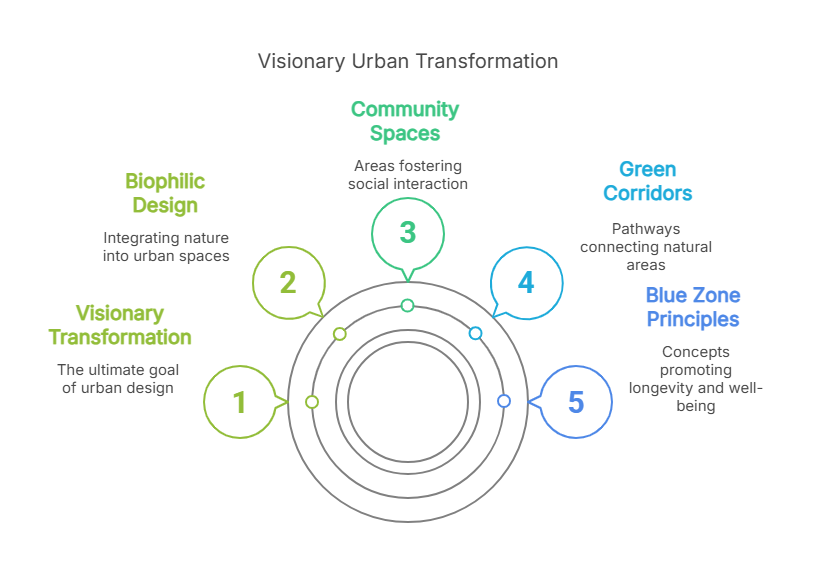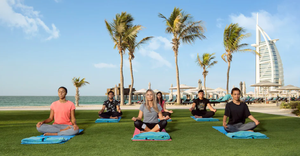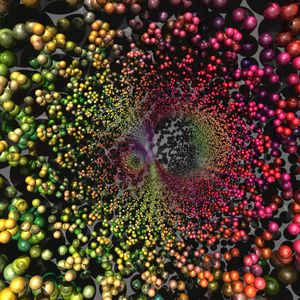The Environment That's Silently Shaping Your Wellbeing
I was walking through a vibrant city center recently when something profound struck me: What if our struggle with burnout, chronic fatigue, and disconnection isn't about personal discipline at all? What if it's actually about the environments we've unconsciously designed around ourselves?
The people in global Blue Zones—regions where centenarians thrive—don't live longer because they have superhuman willpower. They live in environments that make wellbeing the default setting.
Would you be open to discovering why changing your environment might be more powerful than changing your habits? This perspective transformed my approach to wellbeing, and it's exactly why I wrote extensively about environmental design in the SelfCare Book.
When you understand that your environment is either working for or against your energy levels, everything shifts. This isn't about trying harder—it's about designing smarter. Let me show you how.
The 3 Major Challenges We're Here to Solve Together
- The Material Prosperity Trap: How modern environments like Dubai have mastered economic opportunity but need the missing "legs" of wellbeing, connection, and purpose to create sustainable fulfillment
- The Environmental Disconnect: Why today's urban spaces often create isolation and stress instead of natural vitality and community
- The Design-Driven Solution: How purposeful environmental engineering—precisely what Dubai is uniquely positioned to pioneer—can make wellbeing the default rather than requiring constant willpower
What if I told you that people in Blue Zones—regions where people commonly live to 100+ in good health—don't struggle with discipline or willpower? Instead, they live in environments that make wellbeing the default. I've seen firsthand how this approach transforms lives in our SelfCare Community, where members are creating their own micro blue zones inspired by these principles.
The SelfCare Framework: Learn-Do-Embody-Teach
When it comes to environmental wellbeing, our framework provides a clear path:
1. LEARN: Understanding Dubai's Unique Opportunity
Dubai possesses extraordinary advantages for becoming the world's first engineered Blue Zone: visionary leadership, financial resources, innovation culture, multicultural population, world-class infrastructure, year-round sunshine, and strong family values—all critical foundations for wellbeing design.
2. DO: Implementing Blue Zone Principles
Imagine Dubai communities transformed through walkable neighborhoods, green corridors, community gardens, outdoor gathering spaces, intergenerational housing, community centers, and preventive health facilities—all making wellbeing the default choice rather than the difficult one.
3. EMBODY: Becoming a Model of Wellbeing
As Arianna Huffington notes, "Money and power by themselves are a two-legged stool—you can balance on them for a while, but eventually you're going to topple over." Dubai has the opportunity to embody the missing legs: environmental design that supports wellbeing, connection, and purpose.
4. TEACH: Creating a Global Blueprint
Dubai's potential transformation into a Blue Zone isn't just about local wellbeing—it's about creating a replicable model that could transform urban environments worldwide, addressing our global epidemics of chronic disease, disconnection, and purposelessness.
Why Dubai's Vision Matters for Your Personal Wellbeing
Have you ever wondered why it's so hard to maintain healthy habits despite your best intentions? The research reveals a startling truth: your environment is likely working against you.
Modern urban spaces often create what I call "depletion by design"—environments that systematically drain your energy, disconnect you from others, and diminish your sense of purpose. Dubai, despite its extraordinary achievements in infrastructure and prosperity, faces these same modern challenges: high diabetes rates, rising obesity, stress-related illness, mental health concerns, and social disconnection.
The transformative insight is this: Dubai's unique combination of resources, vision, and need creates the perfect conditions to pioneer what no other city has done—purposefully design a Blue Zone from the ground up. The principles being explored there reveal what's possible in your own life and environment:
- Physical spaces that encourage natural movement rather than sedentary living
- Community design that facilitates meaningful connection rather than isolation
- Cultural surroundings that reinforce purpose and meaning rather than emptiness
- Food systems that make healthy eating the default choice rather than the exception
May I ask—which aspect of Dubai's potential transformation most resonates with your own wellbeing challenges?

Creating Your Personal Blue Zone
What makes Dubai's potential Blue Zone vision so exciting isn't just what it means for one city—it's what it teaches all of us about our power to transform our personal environments, regardless of where we live.
Would you be curious to know the three most powerful environmental shifts that members of our community have implemented to transform their energy and purpose, inspired by Blue Zone principles?
- Design for natural movement: Reconfigure your spaces to require natural movement throughout the day, just as the walkable neighborhoods proposed for Dubai would do
- Create connection zones: Designate areas specifically for meaningful interaction, mirroring the community centers and gathering spaces in the Dubai Blue Zone vision
- Build food environments that nourish: Transform your kitchen and food storage to make healthy choices the default, similar to Dubai's proposed indoor farming and community kitchens
Remember what Dan Buettner discovered in his Blue Zone research: "The secret to longevity isn't discipline or determination. It's environment." When you transform your surroundings, new behaviors emerge naturally, without relying on willpower or discipline.
The research is unequivocal—your biology responds to your environment at levels deeper than conscious choice. This is precisely why Dubai's vision of becoming the world's first engineered Blue Zone represents such a powerful model for what's possible in environmental design—both for cities and for individuals.
Your Next Step: Begin Your Environmental Transformation
The most profound shift happens when you stop trying to change yourself and start changing what surrounds you. Your environment is either working for or against your wellbeing—there is no neutral ground.
Would you be open to exploring how to create your own personal Blue Zone, inspired by the ambitious vision being explored in Dubai? Our community is filled with people who are implementing these principles and experiencing remarkable transformations in their energy, connection, and purpose.
To learn the exact system for designing your environment for optimal wellbeing, grab a copy of the SelfCare Book or join our vibrant community where we're sharing these environmental design principles every day.
Remember: You don't need to move to a Blue Zone—or wait for Dubai to build one—you can create one right where you are.
Key Research References:
Level 1 Evidence - Systematic Reviews
- Buettner, D., & Skemp, S. (2016). Blue Zones: Lessons From the World's Longest Lived. American Journal of Lifestyle Medicine, 10(5), 318–321.
- Poulain, M., et al. (2013). Identification of a geographic area characterized by extreme longevity in the Sardinia island: the AKEA study. Experimental Gerontology, 48(8), 955-962.
- Anselmi, V., et al. (2024). Social determinants of health in Blue Zones: A systematic review. Preventive Medicine Reports, 35, 102362.
Level 5 Evidence - Accredited Health Experts Cited
- Dan Buettner, National Geographic Fellow and Blue Zones researcher
- Arianna Huffington, founder of Thrive Global
- Dr. Robert Waldinger, Director of the Harvard Study of Adult Development
Other
- Huffington, A. (2014). Thrive: The Third Metric to Redefining Success and Creating a Life of Well-Being, Wisdom, and Wonder. Harmony Books.
- Buettner, D. (2012). The Blue Zones: 9 Lessons for Living Longer From the People Who've Lived the Longest. National Geographic Books.
REFERENCES
This is directly referenced from the amazon best-selling SelfCare Book "Lifestyle Medicine For the People" by Rory Callaghan. If you would like to read more content like this, grab the free online chapters of the book or a hard copy.
We have done our best to reference everyone's expert opinions, peer-reviewed science, and original thoughts, all references available here and referenced in the text.
We also understand that most thoughts are not our own and there is a collective unconsciousness, unconsciousness, and universal mind stream of energy that is always at work. How our references are sorted and filtered is here.
This article is for informational purposes only and should not replace professional medical advice. Always consult with your healthcare provider before beginning any new health regimen.




